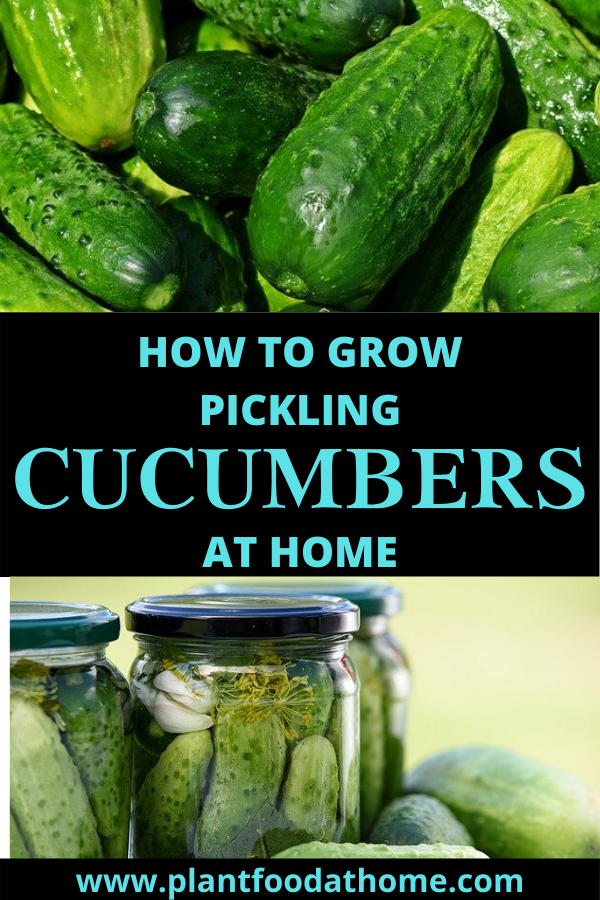Homegrown cucumbers are easy to grow at home and make a delicious addition to salads, and sandwiches. Cucumbers are a delicious ready-to-eat healthy source of nutrition and nothing beats knowing your garden grown cucumbers are free from synthetic fertilizers and pesticides. So in this article, we show you how to grow cucumbers at home, from planting, growing and harvesting so you can enjoy fresh, crisp cucumbers all summer long.
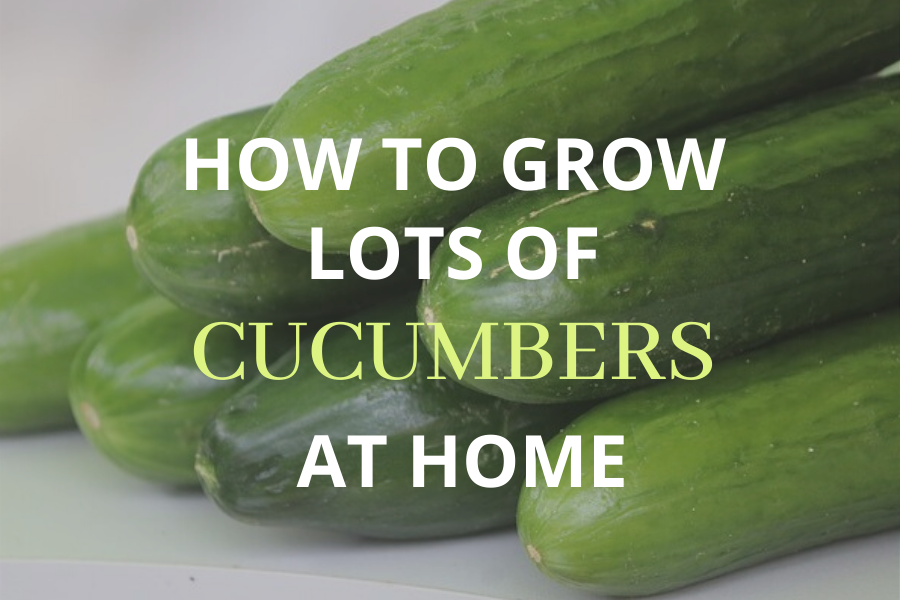
Cucumbers are believed to have originated in India and are grown as a summer fruiting annual vegetable (or rather a fruit). Their crisp and cool nature make them popular in summer salads and pickling varieties are a favorite for their extended shelf-life once pickled.
Table of Contents
Cucumber Varieties
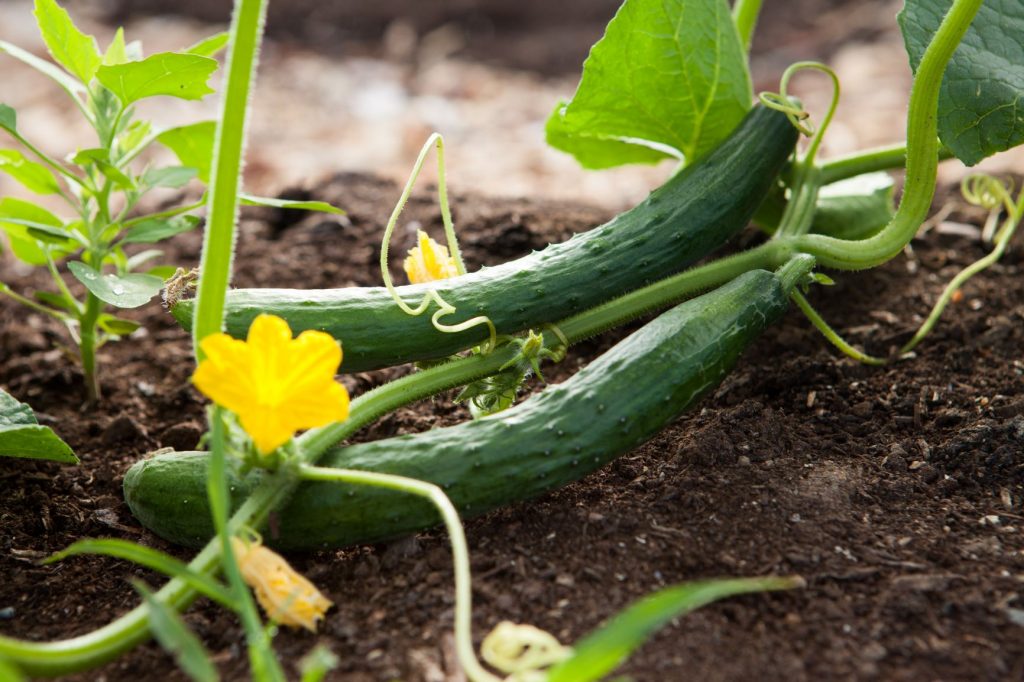
Cucumbers are mostly identified as either ‘slicing’ or ‘pickling’ varieties. And among them, there are many varieties.
Slicing cucumbers are eaten fresh. They have smooth skin and grow 6 to 8 inches (15-20cm) long.
The pickling variety of cucumbers are comparatively shorter in length at 2-4 inches (5-10cm) with bumpy skin.
Both slicing and pickling cucumber varieties come in hybrid and open-pollinated types.
A few popular cucumber varieties include:
Slicers: heirloom – Japanese Climbing, Marketmore, Longfellow, hybrids – Early Pride, Fanfare, Burpless.
Bush or Container Cucumbers: Salad Bush, Spacemaster and Bush Pickle.
Pickling Cucumbers: Boston Pickling, Little Leaf, A & C Pickling, Parisian.
Ideal Growing Conditions
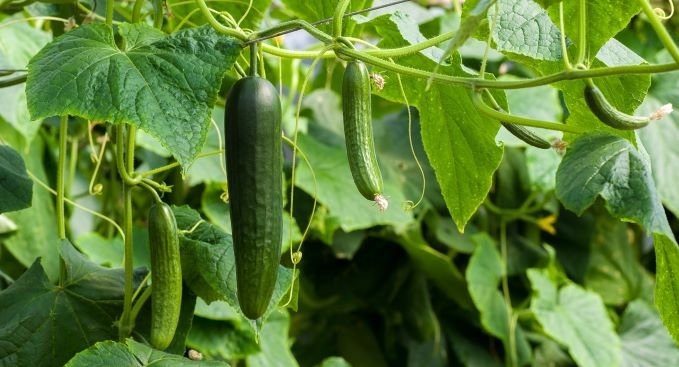
Cucumbers will grow almost anywhere with sun and water. But they will provide a better harvest in their ideal growing conditions.
Most cucumber plants are vines, growing up to 8 feet (2.4mts). Plants can naturally sprawl on the ground or they can be trained to grow up a trellis, fence or a cage and save space.
But left to grow on the ground, cucumber plants will take up valuable vegetable growing space. And the fruit can potentially be affected by disease. Cucumbers grown on the bare ground may not develop their full color and instead be light in color with whitish marks because they haven’t been exposed to the sun where the fruit touches the soil.
All that said, the cucumber vine will grow happily on the ground and I’ve used this method many times. I can save time by forgoing training the cucumber plant on a structure.
In limited space, growing cucumbers in pots or containers is a great choice. Consider growing a bush or compact variety of cucumber, which produces a smaller plant with full-sized fruit. Cucumbers in pots need soil depth of at least 12 inches (30cm).
Sunlight and Warmth for Growing Cucumber
To produce a bountiful harvest, cucumbers need plenty of sunlight. Ideally, cucumbers require full sun which is at least 6-8 hours of sunlight a day.
While cucumbers are a warm-season crop, in extreme heat and sunlight, plants may require some protection to ensure the cucumber plant doesn’t produce an excess of male flowers only and/or turn the cucumbers bitter.
Growing Cucumbers – Ideal Soil
The ideal soil for growing cucumbers is free draining and fertile with added compost and aged manure. Cucumbers are heavy feeders, so starting with improved soil will help produce a productive crop.
The pH of the soil should be around 6 to 7 and you can check your pH level with a soil gauge.
Soil-borne diseases can affect cucumber plants. Minimize the risk by practising 3-year crop rotation. This just means do not plant cucumbers the same place for 3 years.
Cucumber Plant Water Requirements
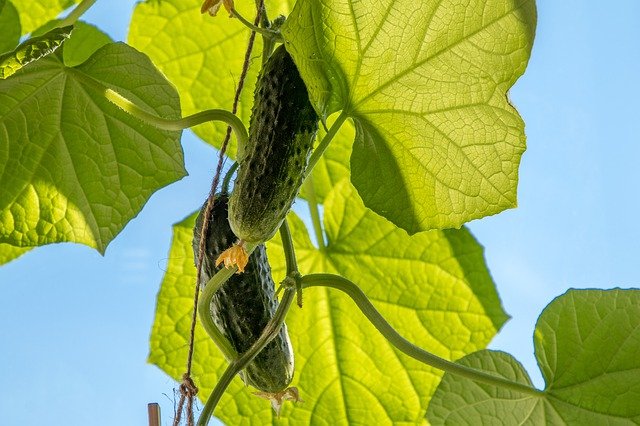
Cucumbers need a generous amount of water. Did you know they are made up of over 90% water? Inadequate watering can cause cucumber plants to stop growing or produce bitter cucumbers.
So keep up a good water routine, usually around 1 to 2 inches (25-50mm) of water twice a week will be ideal watering for cucumber plants. Increase water to about a gallon (3.7lt) throughout the week once fruit forms. You can monitor the water level with a water gauge.
Avoid watering the leaves if possible, as this will encourage disease. Instead, water the soil around the plant.
If there is rain, your cucumber plant does not require additional watering during that time.
Use of organic mulch around the cucumber plant will help retain moisture.
- Related reading: Why are Burpless Cucumbers Called Burpless?
When and How to Plant Cucumbers
Growing cucumbers requires warm weather. The ideal temperature of the soil should be 70F (21C) or above. You can check soil temperature with a soil thermometer. Below this temperature and cucumbers won’t germinate.
Start seed indoors, 2-3 weeks before the last expected frost date. Or wait until the soil is warm enough and sow directly in the ground to minimize transplant loss and shock. In warm soil, cucumbers grow quickly and can quickly surpass the growth of those started indoors.
Sow cucumber seeds about 1/2 inch (1.5 cm) deep and 12 inches (30cm) apart. Or plant seedlings 12 inches (30cm) apart in rows along the support structure if using one. Gently water the soil and keep moist until seedlings emerge in 7-10 days.
Use an organic mulch on the soil to conserve soil moisture and help protect the cucumber plants from drying out.
Bush or compact varieties can be grown closer together at around 6 inches (15cm) apart.
Once the plant starts to flower and sets fruit, you can fertilize cucumber plants with organic fertilizer, fish emulsion or a side dressing of compost. Cukes are heavy feeders so you can support them with a monthly application of fertilizer at this stage. Check the label for the ideal application and frequency.
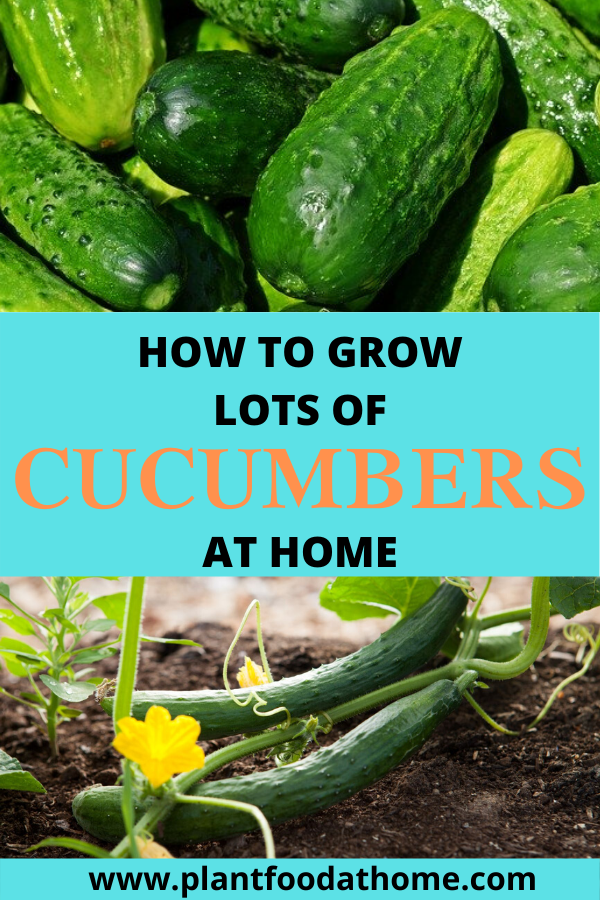
How Long Do Cucumbers Take to Grow?
Generally, cucumbers take 60-70 days to mature and start bearing fruit.
They can grow 2 to 24 inches long, depending on the variety of cucumber.
In warm climates you can succession plant for additional crops and really grow lots of cucumbers. Plant new cucumber seed every 3-4 weeks up to 10 weeks before the first frost.
How Many Cucumbers Can You Get From One Cucumber Plant?
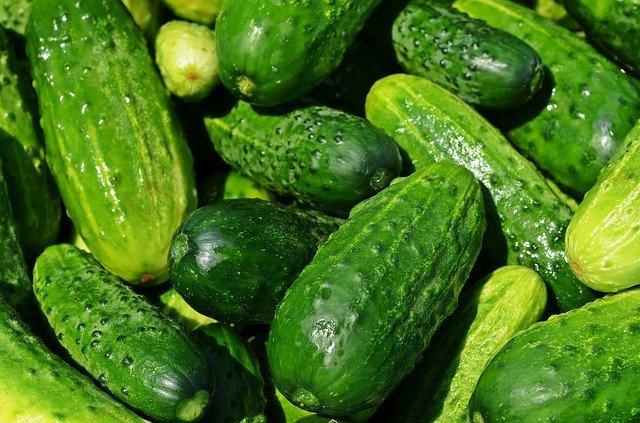
On average, a pickling cucumber plant will yield 5 pounds (2.25kg) of cucumber from one plant and a slicing cucumber plant will produce 10-20 cucumbers.
To produce enough cucumbers for a household, plant 2 to 3 cucumber plants per person.
Harvesting Cucumbers
To harvest cucumbers, use a knife or garden pruners to cut the stem above the cucumber fruit.
Harvesting cucumbers regularly encourages plants to produce more cucumbers and therefore gives you a better yield. Check mature cucumber plants every couple of days for ripe cucumbers.
The best cucumbers to harvest are the ones that are crisp, hard, and evenly green.
Most slicing cucumbers should be harvested when they are 5-6 inches (12.5-15cm) long and pickling cucumbers at 2-4 inches (5-10cm ) depending on the variety.
If you do not harvest the cucumbers from your plant and instead allow the fruit to grow big, you’ll notice a decrease in the yield of the fruit. This is because the plant thinks it has done its job and no longer needs to produce cucumbers.
Cucumbers can be stored unwashed in the fridge crisper for about a week.
If you’re looking for a delicious way to use your cucumbers, have a look at our Easy Watermelon Salad Recipe with Feta, Mint, Balsamic and this Indian Cucumber Raita Recipe.
Cucumber Pests and Problems
Cucumber beetles and powdery mildew are the most common pest and problems of cucumbers.
Control cucumber beetle with horticultural neem oil. You can also consider a row cover before flowers appear but this will need to be removed for pollination.
And for a natural solution for dealing with powdery mildew, you can make up a milk spray. You can read more in our article Milk Spray Recipe For Powdery Mildew.
Remember to practice crop rotation to reduce the likelihood of the cucumber plant being affected by a soil-borne disease.
You can read more about cucumber pests in our article: What’s Eating My Cucumbers? And How to Get Rid of Them!
Are cucumbers turning yellow? We have an article with the possible reasons here 7 Reasons Why Your Cucumbers are Turning Yellow.
Growing Cucumbers Technical Terms Simplified
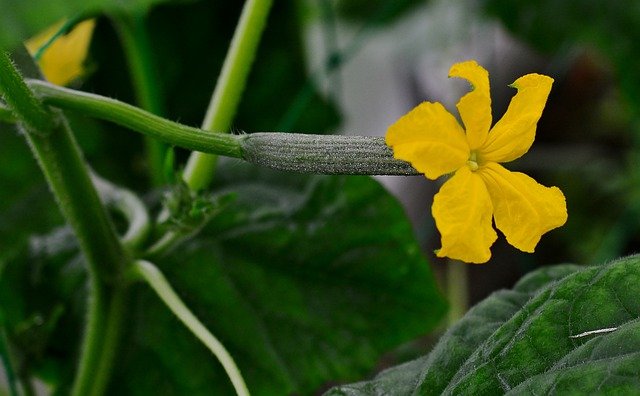
Many cucumber varieties produce both male and female flowers. This type of cucumber is known as ‘monoecious’. Male flowers start a week or two before the female flowers. Female flowers are identified by having a small fruit behind them whereas male flowers do not.
Low cucumber fruit yield is not always due to diseases or insects but can be due to a lack of pollination. You can pollinate the plants manually by placing cotton bud or small paintbrush in the male pollen and then transferring it to the female flower.
Cucumber varieties that don’t need pollination are called ‘parthenocarpic’ fruit. Examples are cucumber hybrid varieties ‘Sweet Success’ and ‘Parks all Season’. They set fruit on every flower.
Then there are ‘gynoecious’ cucumbers, bred to produce mainly female flowers. Monoecious seed is included in the seed packets to provide pollination, often dyed a different color for identification.
- Related reading: Cucumber Flowers But No Fruit? Causes and Solutions
Conclusion
Providing warm fertile soil, full sun and plenty of water, you too can grow lots of cucumbers at home. Now the only decision to make is should you grow cucumber slicers or pickling cucumbers? But then, why not grow both and really enjoy a bountiful harvest of cucumbers this season!
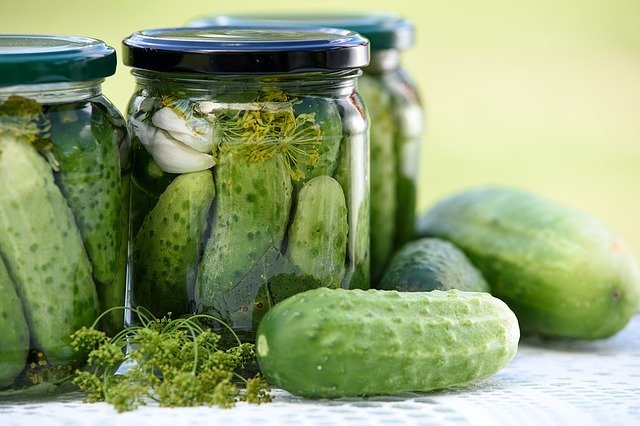
Recommended Products
- Water, Soil and Light Gauge – monitor the water, soil and light with this 3 in 1 gauge.
- Soil Thermometer – measure the soil temperature to ensure enough warmth for seed germination.
- Cucumber Trellis – save space in the garden and grow cucumbers on a trellis.
- Organic Fertilizer – cucumbers are heavy feeders, you can support their growth with organic fertilizer.
- Fish Emulation – support cucumber growth with fish emulsion.
- Horticultural Neem Oil – control cucumber beetle with neem oil.
- Row Cover
- Garden Pruners
If you are growing pickling cucumbers you might like to also grow dill. You can read our article How To Grow An Abundance Of Dill For Your Edible Garden.
And if you’d like to grow more edibles in your garden, how about:
- Growing Cucamelons: Planting, Caring and Harvesting Cucamelon
- How To Grow Eggplant – A Beginners Guide
- How To Grow Sugar Snap Peas: Growing Guide And Tips
- Best Tomatoes To Grow in Pots
- How To Grow Swiss Chard For Fast Leafy Green Vegetables
- How To Grow Delicious Lettuce – Fast Growing Vegetable
- Growing Pumpkins Successfully At Home
